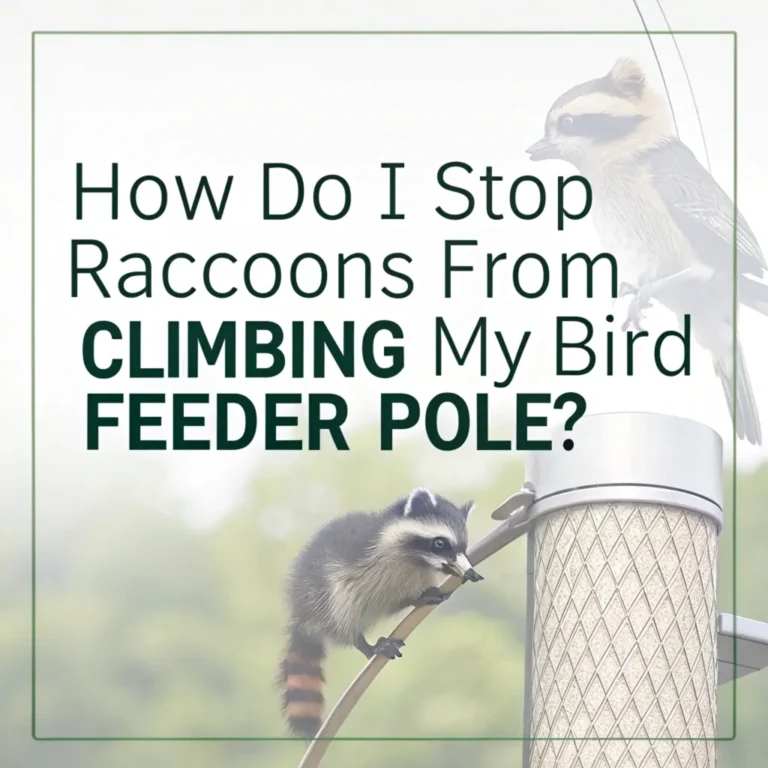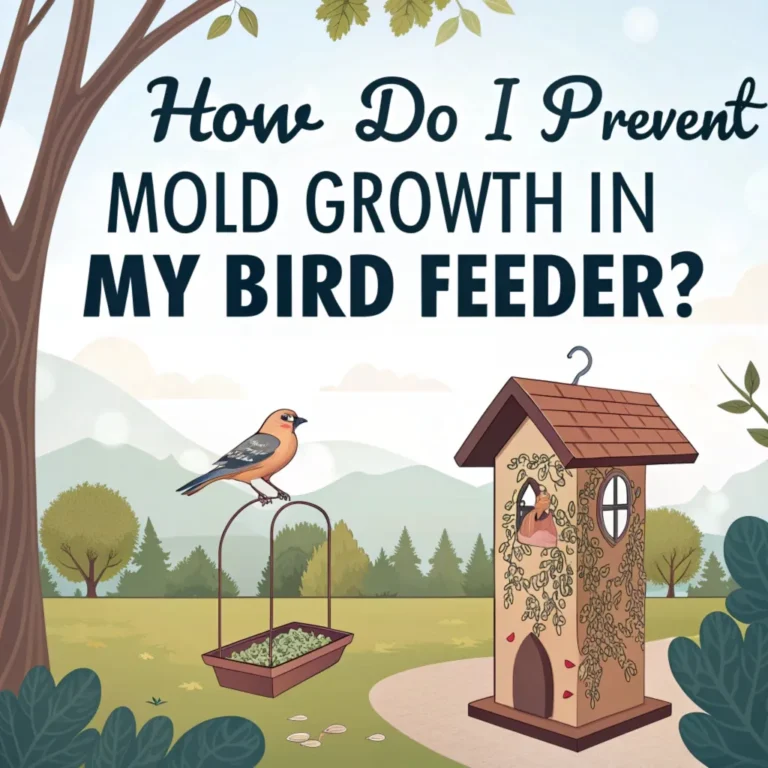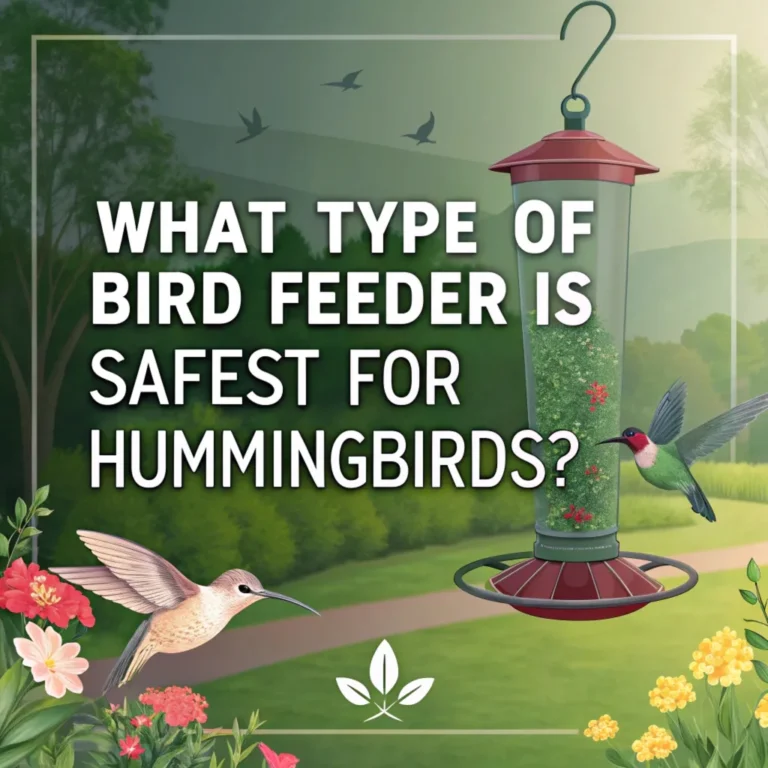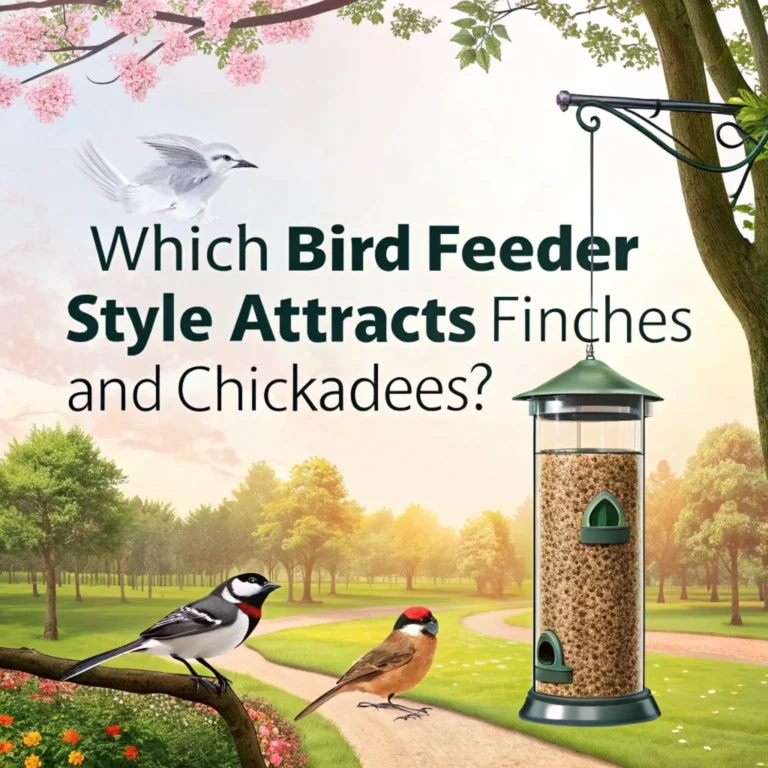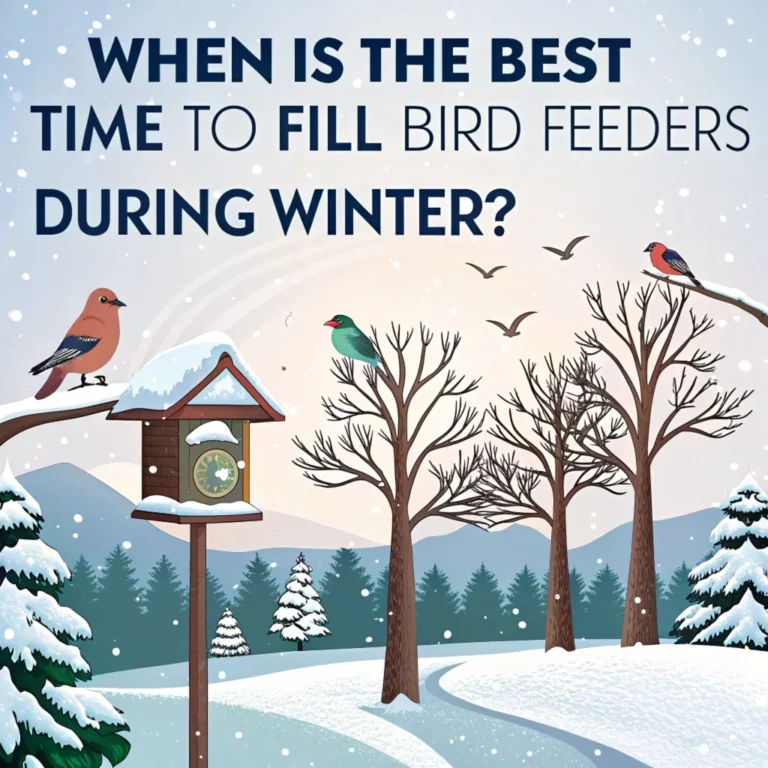How Do I Protect Bird Feeders From Rain and Snow?
Protecting bird feeders from rain and snow is vital for bird care. This guide offers simple ways to keep feeders dry and safe. You will learn how to choose the right feeders, place them well, and maintain them.
These steps help birds access food in all weather. By following these tips, you can support local birds year-round. This article covers everything from feeder design to food selection.
It aims to help both new and experienced bird enthusiasts. With these methods, you can ensure your feathered visitors have a reliable food source, even in harsh conditions.

Key Takeaways
- Use covered feeders or install rain guards to shield food from moisture
- Clean feeders regularly to prevent mold and bacteria growth
- Position feeders strategically under natural shelter or overhangs
- Choose weather-resistant seeds that won’t spoil quickly when wet
- Install drainage systems in feeders to prevent water accumulation
- Offer high-energy foods like suet during wet and cold weather
- Adjust feeding frequency during rainy periods to prevent food waste
- Use weather-resistant materials for feeders to withstand elements
- Provide nearby shelter for birds to take refuge during storms
- Monitor feeder condition regularly and replace damaged ones promptly
- Consider ground feeding areas for species that prefer foraging on the ground
- Implement squirrel baffles to serve dual purpose as rain shields
- Use mesh feeders to allow water to pass through easily
- Add gravel or mesh to feeder bottoms for improved drainage
- Rotate feeder locations to prevent ground saturation in one area
Protecting bird feeders from rain and snow is crucial for maintaining a healthy bird population in your backyard. By implementing these strategies, you can ensure that birds have access to food throughout the year, even during harsh weather conditions.
Proper feeder maintenance not only benefits the birds but also enhances your birdwatching experience, allowing you to observe a diverse range of species visiting your feeders.
Remember that consistency is key when it comes to bird feeding. Birds come to rely on the food sources you provide, especially during challenging weather.
By taking steps to protect your feeders, you’re helping to support local bird populations and contributing to their overall well-being.
Choose Weather-Resistant Feeders
Selecting the right feeder is crucial for protecting bird food from rain and snow. Weather-resistant feeders made from durable materials like plastic or metal can withstand harsh conditions.
These feeders often feature built-in covers or roofs that shield the food from direct exposure to precipitation.
When choosing a weather-resistant feeder, consider the specific needs of the birds in your area. Some feeders are designed to accommodate larger birds, while others are better suited for smaller species.
Look for feeders with features like perches and seed ports that allow easy access for birds while minimizing exposure to the elements.
Proper maintenance of weather-resistant feeders is essential for their longevity. Regularly inspect the feeder for any signs of wear or damage, and clean it thoroughly to prevent the buildup of mold or bacteria.
Install Rain Guards

Rain guards act as umbrellas for your bird feeders. These clear plastic domes hang above feeders, providing an extra layer of protection. They not only keep the food dry but also offer birds a sheltered spot to feed during wet weather.
Rain guards come in various sizes and styles to fit different types of feeders. When installing a rain guard, ensure it’s positioned at the correct height to provide maximum coverage without interfering with birds’ access to the food.
Some rain guards are adjustable, allowing you to customize the protection based on weather conditions.
In addition to protecting against rain, these guards can also help deter larger birds and squirrels from accessing the feeder. This dual functionality makes them a valuable addition to any bird feeding station.
Use Covered Feeders
Feeders with built-in covers or roofs are ideal for rainy and snowy conditions. These designs keep seeds dry and accessible to birds. Hopper feeders and tube feeders with covers are excellent choices for wet weather.
Covered feeders not only protect the food but also provide birds with a sheltered feeding spot. This can be particularly beneficial during light rain or snow, as birds can continue to feed comfortably.
When selecting a covered feeder, look for models with adequate ventilation to prevent moisture buildup inside the feeder.
Regular cleaning of covered feeders is crucial, especially in humid conditions. Moisture can accumulate in enclosed spaces, potentially leading to mold growth. Ensure that the feeder design allows for easy disassembly and cleaning.
Improve Drainage

Proper drainage prevents water from accumulating in feeders. Drill small holes in the bottom of feeders to allow water to escape.
Adding a layer of gravel or mesh at the base of the feeder can also help elevate seeds above any collected moisture.
Improved drainage not only keeps the seed dry but also helps maintain the overall hygiene of the feeder.
Stagnant water can quickly become a breeding ground for bacteria and mold, which can be harmful to birds. By ensuring proper drainage, you’re creating a healthier feeding environment.
Consider the placement of your feeder when improving drainage. Position it in a way that allows water to flow away from the feeding area, preventing puddles from forming beneath the feeder.
Position Feeders Strategically
Place feeders in locations that offer natural protection from the elements. Positioning feeders under tree branches, eaves, or awnings can provide additional shelter from rain and snow.
Strategic placement not only protects the feeder but also creates a more comfortable feeding environment for birds. Look for spots that offer a balance between shelter and visibility, allowing birds to feed while remaining alert to potential predators.
Consider creating multiple feeding stations around your yard to provide options for different species.
Be mindful of the surrounding landscape when positioning feeders. Avoid placing them near dense bushes or areas where predators might hide.
Offer High-Energy Foods
During wet and cold weather, birds need more energy. Provide foods rich in fats and proteins, such as suet cakes, peanuts, and black oil sunflower seeds.
These foods help birds maintain their body heat and energy levels in challenging conditions.
High-energy foods are particularly important during winter months when natural food sources may be scarce.
Consider offering a variety of high-fat options to attract different species. Suet feeders with protective cages can help keep the food dry while allowing birds easy access.
Remember to adjust the quantity of high-energy foods based on the number of birds visiting your feeders. These foods can spoil quickly in wet conditions, so it’s important to monitor consumption and replace them regularly.
Clean Feeders Regularly
Wet conditions can promote the growth of mold and bacteria. Clean feeders weekly using a solution of one part bleach to nine parts water. Rinse thoroughly and allow feeders to dry completely before refilling.
Regular cleaning is crucial for maintaining a healthy feeding environment for birds. Pay special attention to areas where moisture tends to accumulate, such as corners and crevices. Use a brush to scrub away any built-up debris or mold.
Consider having multiple feeders so you can rotate them, allowing each one to dry thoroughly between cleanings.
In addition to cleaning the feeder itself, don’t forget to clean the area around it. Remove any wet or moldy seed that has fallen to the ground to prevent the spread of disease.
Use Weather-Resistant Seeds
Some seeds hold up better in wet conditions. Safflower seeds, sunflower seeds, and peanuts are less likely to spoil quickly when exposed to moisture. Avoid using mixed seed blends that contain fillers, as these can become soggy and spoil rapidly.
When using weather-resistant seeds, consider the preferences of the birds in your area. Different species have different dietary needs and preferences.
Experiment with various types of weather-resistant seeds to see which ones attract the most birds to your feeders.
Store your bird seed properly to maintain its quality. Keep it in a cool, dry place in airtight containers to prevent moisture absorption and pest infestations.
Implement Squirrel Baffles
Squirrel baffles can serve a dual purpose. While designed to deter squirrels, they can also act as rain shields when positioned above feeders. This added protection keeps both squirrels and water away from the bird food.
When installing squirrel baffles, ensure they are large enough to provide adequate coverage for the feeder.
Position them at the correct height to prevent squirrels from jumping over or around them. Some baffles are adjustable, allowing you to customize the protection based on your specific feeder setup.
Regular maintenance of squirrel baffles is important to ensure their effectiveness. Clean them periodically to remove any debris or buildup that might affect their performance.
Provide Nearby Shelter
Create sheltered areas near your feeders where birds can take refuge during storms. Dense shrubs, brush piles, or man-made structures like roosting boxes offer birds a place to wait out bad weather.
Providing shelter not only protects birds from the elements but also creates a more attractive habitat for them.
Consider planting native shrubs and trees that offer both food and shelter. This can help create a year-round bird-friendly environment in your yard.
Ensure that sheltered areas are close enough to feeders for easy access but far enough away to prevent predators from using them as hiding spots.
Monitor Feeder Condition
Regularly inspect your feeders for damage or wear. Replace cracked or broken feeders promptly to prevent water from seeping into the food.
Check for any loose parts or deteriorating materials that might compromise the feeder’s ability to protect food from the elements.
Monitoring feeder condition is crucial for maintaining a safe feeding environment for birds. Look for signs of wear such as rust on metal parts, cracks in plastic components, or warping in wooden feeders. Pay special attention to areas where different materials join, as these can be weak points.
Keep a supply of spare parts on hand for quick repairs. This can help you address minor issues before they become major problems.
Consider Ground Feeding Areas
Some bird species prefer to feed on the ground. Create protected ground feeding areas by using covered platform feeders or spreading seed under bushes or overhanging structures.
This allows ground-feeding birds to access food while staying relatively dry.
When creating ground feeding areas, consider using a raised platform to improve drainage. This can help prevent seed from becoming waterlogged and spoiling. Use a material that allows water to pass through easily, such as wire mesh or slotted wood.
Regularly clean and maintain ground feeding areas to prevent the buildup of waste and discourage pests.
Use Mesh Feeders
Mesh feeders allow water to pass through easily, preventing seed from becoming waterlogged. These feeders are particularly suitable for small seeds like nyjer or thistle, which are popular among finches and other small birds.
Mesh feeders come in various sizes and shapes to accommodate different types of seed. Some are designed specifically for certain seed types, while others are more versatile. Consider the feeding habits of the birds in your area when choosing a mesh feeder.
Regular cleaning of mesh feeders is important to prevent clogs and ensure proper seed flow. Use a brush to remove any debris or seed husks that may accumulate in the mesh.
Adjust Feeding Frequency
During periods of heavy rain or snow, adjust how often you replenish feeders. Fill feeders with smaller amounts more frequently to prevent large quantities of seed from getting wet and spoiling. This approach reduces waste and ensures birds have access to fresh food.
Monitoring seed consumption can help you determine the appropriate feeding frequency. Keep track of how quickly birds empty the feeders and adjust your refilling schedule accordingly.
This can also help you identify changes in bird populations or feeding patterns.
Consider using multiple smaller feeders instead of one large feeder. This allows you to rotate feeders more easily and reduces the amount of seed exposed to the elements at any given time.
FAQs
How often should I clean my bird feeders during rainy seasons?
Clean bird feeders at least once a week during rainy seasons. Increased moisture can lead to faster mold and bacteria growth, so more frequent cleaning is necessary to keep feeders safe for birds.
Can I use a rain guard on any type of bird feeder?
Rain guards are most effective on tube feeders and hopper feeders. However, they can be adapted to fit various feeder types. Ensure the guard is large enough to cover the entire feeding area.
What are the best types of seeds to use in wet weather?
Black oil sunflower seeds, safflower seeds, and peanuts are excellent choices for wet weather. These seeds have hard shells that resist moisture and are less likely to spoil quickly when exposed to rain or snow.
How can I prevent seed from getting moldy in my feeders?
To prevent mold, ensure proper drainage in your feeders, clean them regularly, and use weather-resistant seeds. Adding a small amount of food-grade diatomaceous earth to the seed can also help absorb excess moisture.
Is it necessary to provide water for birds during rainy weather?
While birds can find water during rainy weather, providing a clean water source is still beneficial. Fresh water in a bird bath or shallow container gives birds a reliable drinking and bathing spot, especially if natural water sources become contaminated.

Luna is the passionate founder and author of Birds and You, a website dedicated to sharing her love for birds with fellow enthusiasts. Through her engaging articles and guides, she aims to educate and inspire others to explore the fascinating world of birds. When she’s not writing, you can find Luna observing birds in their natural habitats or sharing beautiful bird photography on Pinterest. Join her on this journey to celebrate and protect our feathered friends!


